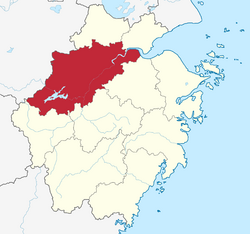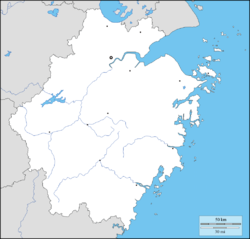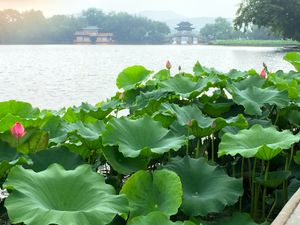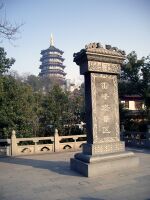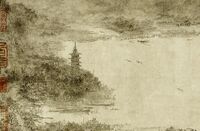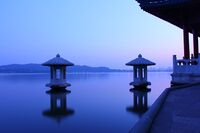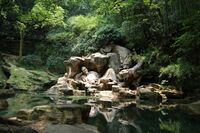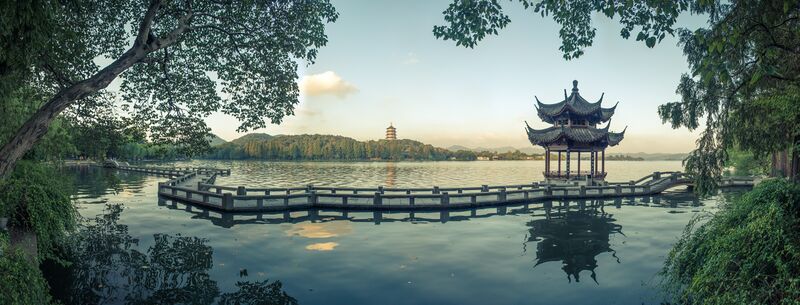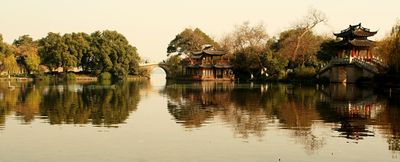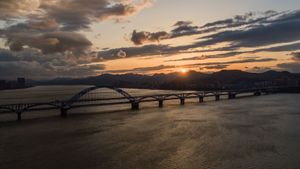هانغتشو
| ||||||||||||||||||||||||||||||||||||||||||||||||||||||||||||||||||||||||||||||||||||||
| ||||||||||||||||||||||||||||||||||||||||||||||||||||||||||||||||||||||||||||||||||||||
هانغتشو أو هانگژو (صينية تقليدية: 杭州; پنين: Hángzhōu; تهجي خريطة البريد: Hangchow) إحدى مدن مقاطعة ژىجيانگ وهي العاصمة السياسية والاقتصادية للمقاطعة ومن المدن السياحية الصينية ، تشتهر بجمالها الطبيعي وتراثها الثقافي، وتصنف في النظام الصيني للتقسيم الإداري على أنها مدينة مقاطعة فرعية ،
تقع في أقصى الجنوب الصيني على نهر چيانتانگ. وفيها بحيرة شيهو( البحيرة الغربية), ويمر بها جدول شيشي وقناة بكين – هانگژو الكبرى و نهر تشيانتانغ و بحر الصين الشرقي. وقد بذلت هانگژو جهودا كبيرة في معالجة مياه البحيرة والنهر والقناة والبحر والجدول حتى صارت مدينة ماؤها نظيف وأنهارها صافية وهواؤها نقي ومناظرها خضراء جميلة. لذا، لم يكن غريبا على هذه المدينة أن تحظى بلقب "المدينة النموذجية في معالجة البيئة المائية بالصين" وأن يقال إن أهلها "أكثر السكان سعادة في الصين".
وقناة بكين – هانگژو الكبرى التي تصب في نهر تشيانتانغ عند جسر قونغتشن. بدأ العمل في قناة بكين – هانغتشو الكبرى في عصر الربيع والخريف (711ق. م-221ق.م)، وتواصل في أسرة سوي (581-618م) وأسرة يوان (1271-1368م)، ومن ثم بقيت على ضفتي القناة في هانغتشو آثار حضارية تاريخية لمختلف الأسر الصينية.
"الجنة في السماء، وسوتشو وهانغتشو على الأرض". هكذا قال الصينيون منذ قديم الزمان، اعتقادا منهم بأن هاتين المدينتين هما أجمل مدن العالم كله. يكمن جمال هانغشو في مائها الذي يشكل 8% من مساحتها.
بفضل مفهوم معالجة مياه البحيرة والنهر والقناة والبحر والجدول معا، وقع الاختيار على هانغتشو لتكون ضمن منطقة "أفضل ممارسة حضرية" في إكسبو شانغهاي.
وتعد هانگژو من المدن الرئيسية في دلتا شانغ يانغ، مناخ المدينة شبه استوائي وتمر عليها الفصول الأربعة, تتكون المدينة من 6 مناطق وحيين و 5 بلديات تغطي 16596 كيلومتر مربع يقطنها ما يقارب الستة ملايين نسمة.
الجزء الغربي لمدينة هانگژو أقل ارتفاعا عن سطح البحر من جزئها الشرقي، فتم توظيف هذا الوضع الطبوغرافي لجعل المياه تتدفق من الأماكن العالية إلى غربي المدينة، وتصفيتها خلال جريانها لمسافة طويلة فارتفعت جودة المياه بشكل ملموس. كما طبقت المدينة تكنولوجيا المعالجة البيولوجية لحماية ومعالجة وتحسين النظام الإيكولوجي، فارتفعت جودة المياه وتحسنت البيئة في نفس الوقت، وصارت بحيرة شيهو ونهر شيشي أكثر جذبا للأحياء المائية. إن تكنولوجيا المعالجة البيولوجية ونظام التصفية الطبيعية المنخفض التكلفة والعالي الفعالية يستحقان أن يعمما في العالم.
بعد الحماية الشاملة والمعالجة، توسعت مساحة بحيرة شيهو، وتحسنت البيئة الإيكولوجية لمنطقة البحيرة والأراضي الرطبة لنهر شيشي، وأصبحت حديقة نهر شيشي أول حديقة وطنية للأرض الرطبة في الصين. وبالإضافة إلى ذلك، حددت حكومة المدينة بعض المناطق يُحظَر فيها إشعال المفرقعات وتربية الحيوانات، ونقلت المؤسسات الصناعية إلى خارج التجمعات السكنية وأنشأت محطة ضخمة لمعالجة المياه المستخدمة واتخذت إجراءات للسيطرة على انبعاثات المواد الملوثة، وتم تطهير نهر تشيانتانغ، وسحب المياه الجارية من نهر تشيانتانغ وضخها في قناة بكين–هانگژو الكبرى. وهكذا، بعد عشرات السنوات عانت فيها القناة من انسداد مجراها، صارت مياهها صافية وعلى ضفتيها ممران جميلان طولهما 21 كيلومترا..[4]
التاريخ
هانگژو هي أحد مهود الحضارة الصينية حيث سكنها الإنسان منذ 4700 سنة وأول من سكنها قبيلة تدعى ليانجتشو و كانت المدينة عاصمة مملكة وو وأيضا مملكة يي كما كانت أيضا عاصمة أسرة سونگ الجنوبية وأول من أعلنها مقاطعة هو الإمبراطور جينج .
التاريخ المبكر
The celebrated neolithic culture of Hemudu is known to have inhabited Yuyao, 100 km (62 mi) south-east of Hangzhou, as far back as seven thousand years ago.[5] It was during this time that rice was first cultivated in southeast China.[6] Excavations have established that the jade-carving Liangzhu culture (named for its type site just northwest of Hangzhou) inhabited the area immediately around the present city around five thousand years ago.[7] The first of Hangzhou's present neighborhoods to appear in written records was Yuhang, which probably preserves an old Baiyue name.[8]
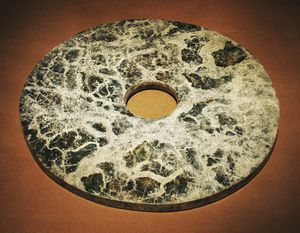
Hangzhou was made the seat of the prefecture of Hang in AD 589, entitling it to a city wall which was constructed two years later. By a longstanding convention also seen in other cities like Guangzhou and Fuzhou, the city took on the name of the area it administered and became known as Hangzhou. Hangzhou was at the southern end of China's Grand Canal which extends to Beijing. The canal evolved over centuries but reached its full length by 609.[9]
أسرة سونگ
In 1089, while another renowned poet Su Shi (Su Dongpo) was the city's governor, he used 200,000 workers to construct a 2.8 km (1.7 mi) long causeway across West Lake. The lake was once a lagoon tens of thousands of years ago. Silt then blocked the way to the sea and the lake was formed. A drill in the lake-bed in 1975 found the sediment of the sea, which confirmed its origin. Artificial preservation prevented the lake from evolving into a marshland. The Su Causeway built by Su Shi a Tang dynasty poet who was once the governor of Hangzhou, built out of mud dredged from the lake bottom. The lake is surrounded by hills on the northern and western sides. The Baochu Pagoda sits on the Baoshi Hill to the north of the lake.

Arab merchants lived in Hangzhou during the Song dynasty, due to the fact that the oceangoing trade passages took precedence over land trade during this time.[10] There were also Arabic inscriptions from the 13th century and 14th century. During the later period of the Yuan dynasty, Muslims were persecuted through the banning of their traditions, and they participated in revolts against the Mongols.[11] The Fenghuangshi mosque was constructed by an Egyptian trader who moved to Hangzhou.[12] Ibn Battuta is known to have visited the city of Hangzhou in 1345; he noted its charm and described how the city sat on a beautiful lake and was surrounded by gentle green hills.[13] During his stay at Hangzhou, he was particularly impressed by the large number of well-crafted and well-painted Chinese wooden ships with colored sails and silk awnings in the canals. He attended a banquet held by Qurtai, the Yuan Mongol administrator of the city, who according to Ibn Battuta, was fond of the skills of local Chinese conjurers.[14]


Hangzhou was chosen as the new capital of the Southern Song dynasty in 1132,[15] when most of northern China had been conquered by the Jurchens in the Jin–Song wars.[16] The Song court had retreated south to the city in 1129 from its original capital in Kaifeng, after it was captured by the Jurchens in the Jingkang Incident of 1127.[17][18] From Kaifeng they moved to Nanjing, modern Shangqiu, then to Yangzhou in 1128.[17] The government of the Song intended it to be a temporary capital. However, over the decades Hangzhou grew into a major commercial and cultural center of the Song dynasty. It rose from a middling city of no special importance to one of the world's largest and most prosperous.[19] Once the prospect of retaking northern China had diminished, government buildings in Hangzhou were extended and renovated to better befit its status as an imperial capital and not just a temporary one. The imperial palace in Hangzhou, modest in size, was expanded in 1133 with new roofed alleyways, and in 1148 with an extension of the palace walls.[20]
From the early 12th century until the Mongol invasion of 1276، بقيت هانگژو العاصمة وكانت تُعرف بإسم لين آن. It served as the seat of the imperial government, a center of trade and entertainment, and the nexus of the main branches of the civil service. During that time the city was a gravitational center of Chinese civilization: what used to be considered "central China" in the north was taken by the Jin, an ethnic minority dynasty ruled by Jurchens.
Numerous philosophers, politicians, and men of literature, including some of the most celebrated poets in Chinese history such as Su Shi, Lu You, and Xin Qiji came here to live and die. Hangzhou is also the birthplace and final resting place of the scientist Shen Kuo (1031–1095 AD), his tomb being located in the Yuhang district.[21]
During the Southern Song dynasty, commercial expansion, an influx of refugees from the conquered north, and the growth of the official and military establishments, led to a corresponding population increase and the city developed well outside its 9th-century ramparts. According to the Encyclopædia Britannica, Hangzhou had a population of over 2 million at that time, while historian Jacques Gernet has estimated that the population of Hangzhou numbered well over one million by 1276. (Official Chinese census figures from the year 1270 listed some 186,330 families in residence and probably failed to count non-residents and soldiers.) It is believed that Hangzhou was the largest city in the world from 1180 to 1315 and from 1348 to 1358.[22][23]
Because of the large population and densely crowded (often multi-story) wooden buildings, Hangzhou was particularly vulnerable to fires. Major conflagrations destroyed large sections of the city in 1132, 1137, 1208, 1229, 1237, and 1275 while smaller fires occurred nearly every year. The 1237 fire alone was recorded to have destroyed 30,000 dwellings. To combat this threat, the government established an elaborate system for fighting fires, erected watchtowers, devised a system of lantern and flag signals to identify the source of the flames and direct the response, and charged more than 3,000 soldiers with the task of putting out fires.
The city of Hangzhou was besieged and captured by the advancing Mongol armies of Kublai Khan in 1276, three years before the final collapse of the empire.[24] The capital of the new Yuan Dynasty was established in the city of Dadu (Beijing).[25]
The Venetian merchant Marco Polo supposedly visited Hangzhou in the late 13th century. In his book, he records that the city was "greater than any in the world".[19] He called the city Quinsai, a name that—like Odoric of Pordenone's Cansay—derived from its Southern Song nickname Xingzai, "Temporary Residence". Although Polo exaggerated that the city was over one hundred miles in diameter and had 12,000 stone bridges, he still presented elegant prose about the country: "The number and wealth of the merchants, and the amount of goods that passed through their hands, was so enormous that no man could form a just estimate thereof." The renowned 14th-century Moroccan explorer Ibn Battuta said it was "the biggest city I have ever seen on the face of the earth."[26][27]
The city remained an important port until the middle of the Ming dynasty era, when its harbor slowly silted up. Under the Qing, it was the site of an imperial army garrison.[28]
In 1856 and 1860, the Taiping Heavenly Kingdom occupied Hangzhou and caused heavy damage to the city.
أسرة يوان
Hangzhou was besieged and captured by the advancing Mongol armies of Kublai Khan in 1276, three years before the final collapse of the Southern Song.[24] Historian Patricia Buckley Ebrey noted that the Mongol Yuan dynasty treated the Jurchen Wanyan royal family harshly, butchering them by the hundreds as well as the Tangut emperor of Western Xia when they defeated him earlier. However Patricia also noted the Mongols were totally lenient on the Han Chinese Zhao royal family of the Southern Song explicitly unlike the Jurchens during the Jingkang incident, sparing both the Southern Song royals in the capital Hangzhou like the Emperor Gong of Song and his mother as well as sparing the civilians inside it and not sacking the city, allowing them to go about their normal business, rehiring Southern Song officials. The Mongols did not take the southern Song palace women for themselves but instead had Han Chinese artisans in Shangdu marry the palace women.[29] The capital of the new Yuan dynasty was established in the city of Dadu (Beijing), but Hangzhou remained an important commercial and administrative center for their southern territory.
Xi Hu Landscape by Li Song (1190–1264), showing the Leifeng Pagoda in the Southern Song Dynasty.
"Moon over the Peaceful Lake in Autumn", one of the Ten Scenes of the Xi Hu
Dreaming of the Tiger Spring, the burial place of monk Jigong.
وصف الأجانب
Yuan China was very open to foreign visitors, and several returned west describing Hangzhou—under the names Khinzai,[30] Campsay,[31] etc.[note 1] — as one of the foremost cities in the world. The Venetian merchant Marco Polo supposedly visited Hangzhou in the late 13th century. In his book, he records that the city was "greater than any in the world"[19] and that "the number and wealth of the merchants, and the amount of goods that passed through their hands, was so enormous that no man could form a just estimate thereof." The manuscripts of Polo's account greatly exaggerate the city's size, although it has been argued that the "hundred miles" of walls would be plausible if Chinese miles were intended instead of Italian ones[34] and that the "12,000 stone bridges" might have been a copyist error born from the city's 12 gates.[35] In the 14th century, the Moroccan traveler Ibn Battuta arrived; his later account concurred that al-Khansā was "the biggest city I have ever seen on the face of the earth."[36][37][38] He visited Hangzhou in 1345 and noted its charm and described how the city sat on a beautiful lake and was surrounded by gentle green hills.[39] He was particularly impressed by the large number of well-crafted and well-painted Chinese wooden ships with colored sails and silk awnings in the canals. He attended a banquet held by Qurtai, the Yuan Mongol administrator of the city, who according to Ibn Battuta, was fond of the skills of local Chinese conjurers.[40]
التاريخ الحديث
الجغرافيا والمناخ
| هانگژو | ||||||||||||||||||||||||||||||||||||||||||||||||||||||||||||
|---|---|---|---|---|---|---|---|---|---|---|---|---|---|---|---|---|---|---|---|---|---|---|---|---|---|---|---|---|---|---|---|---|---|---|---|---|---|---|---|---|---|---|---|---|---|---|---|---|---|---|---|---|---|---|---|---|---|---|---|---|
| جدول طقس (التفسير) | ||||||||||||||||||||||||||||||||||||||||||||||||||||||||||||
| ||||||||||||||||||||||||||||||||||||||||||||||||||||||||||||
| ||||||||||||||||||||||||||||||||||||||||||||||||||||||||||||

| بيانات المناخ لـ هانگژو (1981–2010 normals, extremes 1951–الحاضر) | |||||||||||||
|---|---|---|---|---|---|---|---|---|---|---|---|---|---|
| الشهر | ينا | فب | مار | أبر | ماي | يون | يول | أغس | سبت | أكت | نوف | ديس | السنة |
| القصوى القياسية °س (°ف) | 23.9 (75.0) |
28.5 (83.3) |
32.8 (91.0) |
34.8 (94.6) |
36.5 (97.7) |
39.7 (103.5) |
40.5 (104.9) |
41.6 (106.9) |
38.7 (101.7) |
35.0 (95.0) |
31.2 (88.2) |
26.5 (79.7) |
41.6 (106.9) |
| متوسط القصوى اليومية °س (°ف) | 8.3 (46.9) |
10.3 (50.5) |
14.8 (58.6) |
21.1 (70.0) |
26.3 (79.3) |
29.1 (84.4) |
33.6 (92.5) |
32.8 (91.0) |
28.2 (82.8) |
23.2 (73.8) |
17.3 (63.1) |
11.3 (52.3) |
21.4 (70.5) |
| المتوسط اليومي °س (°ف) | 4.6 (40.3) |
6.4 (43.5) |
10.3 (50.5) |
16.2 (61.2) |
21.4 (70.5) |
24.7 (76.5) |
28.9 (84.0) |
28.2 (82.8) |
24.0 (75.2) |
18.8 (65.8) |
12.9 (55.2) |
7.0 (44.6) |
17.0 (62.5) |
| متوسط الدنيا اليومية °س (°ف) | 1.8 (35.2) |
3.5 (38.3) |
7.0 (44.6) |
12.4 (54.3) |
17.5 (63.5) |
21.4 (70.5) |
25.2 (77.4) |
24.9 (76.8) |
20.9 (69.6) |
15.4 (59.7) |
9.3 (48.7) |
3.7 (38.7) |
13.6 (56.5) |
| الصغرى القياسية °س (°ف) | −8.6 (16.5) |
−9.6 (14.7) |
−3.5 (25.7) |
0.2 (32.4) |
7.3 (45.1) |
12.8 (55.0) |
17.3 (63.1) |
18.2 (64.8) |
12.0 (53.6) |
1.0 (33.8) |
−3.6 (25.5) |
−8.4 (16.9) |
−9.6 (14.7) |
| متوسط تساقط الأمطار mm (inches) | 80.6 (3.17) |
88.2 (3.47) |
140.7 (5.54) |
123.1 (4.85) |
128.6 (5.06) |
219.4 (8.64) |
172.9 (6.81) |
162.1 (6.38) |
123.5 (4.86) |
78.5 (3.09) |
71.5 (2.81) |
48.9 (1.93) |
1٬438 (56.61) |
| Average precipitation days (≥ 0.1 mm) | 12.4 | 12.1 | 15.3 | 14.5 | 13.8 | 14.6 | 12.4 | 13.8 | 11.7 | 9.0 | 9.3 | 8.5 | 147.4 |
| متوسط الرطوبة النسبية (%) | 75 | 75 | 75 | 74 | 74 | 80 | 76 | 78 | 79 | 76 | 74 | 73 | 76 |
| Mean monthly ساعات سطوع الشمس | 102.0 | 97.2 | 116.4 | 140.6 | 164.7 | 136.6 | 212.7 | 193.0 | 143.9 | 144.6 | 129.0 | 128.7 | 1٬709٫4 |
| Source: China Meteorological Data Sharing Service System[41] | |||||||||||||
التقسيمات الادارية
The sub-provincial city of Hangzhou comprises 9 districts, 2 county-level cities, and 2 counties. The six central urban districts occupy 683 km2 (264 sq mi) and have 3,560,400 people. The three suburban districts occupy 4،193 km2 (1،619 sq mi) and have 3,399,300 people.
| Map | ||||||
|---|---|---|---|---|---|---|
| التقسيم | بالصينية | Pinyin | Population (2010) | المساحة (كم²) | الكثافة | |
| المدينة نفسها | ||||||
| Shangcheng District | 上城区 | Shàngchéng Qū | 344,594 | 18.30 | 18,830.27 | |
| Xiacheng District | 下城区 | Xiàchéng Qū | 526,096 | 31.46 | 16,722.70 | |
| Jianggan District | 江干区 | Jiānggàn Qū | 998,783 | 210.22 | 4,751.13 | |
| Gongshu District | 拱墅区 | Gǒngshù Qū | 551,874 | 87.49 | 6,307.85 | |
| Xihu District | 西湖区 | Xīhú Qū | 820,017 | 308.70 | 2,656.36 | |
| Binjiang District | 滨江区 | Bīnjiāng Qū | 319,027 | 72.02 | 4,429.70 | |
| Suburban | ||||||
| Xiaoshan District | 萧山区 | Xiāoshān Qū | 1,511,290 | 1,420.22 | 1,064.12 | |
| Yuhang District | 余杭区 | Yúháng Qū | 1,170,290 | 1,223.56 | 956.46 | |
| Fuyang District | 富阳区 | Fùyáng Qū | 717,694 | 1,831.20 | 391.93 | |
| County | ||||||
| Tonglu County | 桐庐县 | Tónglú Xiàn | 406,450 | 1,825.00 | 222.71 | |
| Chun'an County | 淳安县 | Chún'ān Xiàn | 336,843 | 4,427.00 | 76.09 | |
| County-level cities | ||||||
| Jiande | 建德市 | Jiàndé Shì | 430,750 | 2,321.00 | 185.59 | |
| Lin'an | 临安市 | Lín'ān Shì | 566,665 | 3,126.80 | 181.23 | |
الاقتصاد

Hangzhou's economy has rapidly developed since its opening up in 1992. It is an industrial city with many diverse sectors such as light industry, agriculture, and textiles. It is considered an important manufacturing base and logistics hub for coastal China.[42]
The 2001 GDP of Hangzhou was RMB ¥156.8 billion, which ranked second among all of the provincial capitals after Guangzhou. The city has more than tripled its GDP since then, increasing from RMB ¥156.8 billion in 2001 to RMB ¥701.1 billion in 2011 and GDP per capita increasing from US$3,025 to US$12,447.[42][43]
السياحة
- مسجد فنگهوانگ (Fenghuang Temple ، 凤凰清真寺) هو أحد أقدم مساجد الصين، والبناء الحالي عند تقاطع طريق شيهو (西湖大道) وطريق ژونگشان المركزي (中山中路) يبلغ عمره 700 سنة، أي من عهد أسرة يوان.
المواصلات
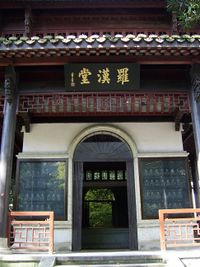
البلدات التوأم – المدن الشقيقة
Hangzhou is twinned with:
| City | Country | since |
|---|---|---|
| Queenstown | غير معروف | |
| Sayama | 1978 | |
| Gifu | 1979 | |
| بوسطن | 1982 | |
| Baguio | 1982 | |
| ليدز | 1988 | |
| Fukui | 1989 | |
| نيس | 1994 | |
| پاراماريبو | 1988 | |
| بوداپست | 1999 | |
| Cape Town | 2005 | |
| درسدن | 2009 | |
| إندياناپوليس | 2009 | |
| أطلنطا | 2012 | |
| دنيپرو | 2013 | |
| Tallinn | Unknown | |
| Weert | Unknown |
Fishers, Indiana is in the exploration process of becoming sister cities with Hangzhou.
مأثورات صينية
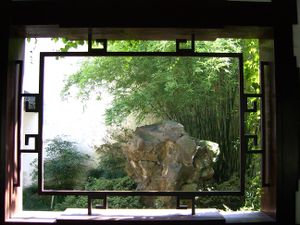
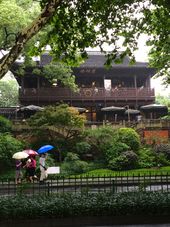
- "Be born in Suzhou, live in Hangzhou, eat in Guangzhou, die in Liuzhou." (الصينية المبسطة: 生在苏州, 活在杭州, 吃在广州, 死在柳州; الصينية التقليدية: 生在蘇州, 活在杭州, 吃在廣州, 死在柳州)
- The meaning here lies in the fact that Suzhou was renowned for its beautiful and highly civilized and educated citizens, Hangzhou for its scenery, Guangzhou for its food, and Liuzhou (of Guangxi) for its wooden coffins which supposedly halted the decay of the body (likely made from the chamfor tree).
- "Heaven Above, Suzhou and Hangzhou below." (الصينية المبسطة: 上有天堂, 下有苏杭; الصينية التقليدية: 上有天堂, 下有蘇杭)
- This phrase has a similar meaning to the English phrases "heaven on Earth" or "God's country".
انظر أيضاً
- Historical capitals of China
- Jiangnan
- Zhejiang Province
- List of cities in the People's Republic of China by population
- Suzhou numerals - in the Unicode standard version 3.0, these characters are incorrectly named Hangzhou style numerals
ملاحظات
- ^ For a discussion of the many sources and variant spellings of the names, see Moule.[32] The ultimate Chinese source of these names has been variously given as Jīngshī (京師, "the Capital"); Xingzai, an abbreviated form of Xíngzàisuǒ (行在所, "the Place of Temporary Residence"), which had formerly been a byname for the Song capital from the hope that the court would eventually return north to Kaifeng; and Hangtsei, the Hangzhounese pronunciation of the town's name.[33]
الهامش
- ^ "China: Zhèjiāng (Prefectures, Cities, Districts and Counties) - Population Statistics, Charts and Map".
- ^ "The city's GDP increased on an annual basis by 8.5%! Hangzhou showed the "transcript" of economic development in 2021" 全市GDP同比增长8.5%! 杭州亮出2021年经济发展"成绩单". January 22, 2022. Archived from the original on January 26, 2022. Retrieved February 25, 2022.
- ^ خطأ استشهاد: وسم
<ref>غير صحيح؛ لا نص تم توفيره للمراجع المسماةssdph.com.cn - ^ "نموذج لمدينة المستقبل في الصين: هانغتشو.. مدينة تتنفس ماء". شبكة الصين العربية. Retrieved 2011-06-30.
- ^ Yan Wenming. "The Beginning of Farming", p. 36, in The Formation of Chinese Civilization: An Archaeological Perspective, pp. 27–42. Yale University Press (New Haven), 2005. ISBN 978-0-300-09382-7.
- ^ Fuller, Dorian; et al. (2009). "The Domestication Process and Domestication Rate in Rice: Spikelet bases from the Lower Yangtze" (PDF). Science. 323 (5921): 1607–1610. Bibcode:2009Sci...323.1607F. doi:10.1126/science.1166605. PMID 19299619. S2CID 21357179. Archived from the original (PDF) on سبتمبر 22, 2017. Retrieved أبريل 20, 2018.
- ^ Shanghai Qingpu Museum. "[museum.shqp.gov.cn/gb/content/2009-02/23/content_237435.htm Migration of the Tribe and Integration into the Han Chinese]". Accessed 24 July 2014.
- ^ 中国历史地名大辞典. Shanghai: Shanghai Lexicographical Publishing House. p. 1516.
- ^ Ebrey, Cambridge Illustrated History of China, 114: "[...] the Grand Canal, dug between 605 and 609 by means of enormous levies of conscripted labour."
- ^ Piper Rae Gaubatz (1996). Beyond the Great Wall: urban form and transformation on the Chinese frontiers (illustrated ed.). Stanford University Press. p. 210. ISBN 0-8047-2399-0. Retrieved 17 July 2011.
- ^ Greville Stewart Parker Freeman-Grenville, Stuart C. Munro-Hay (2006). Islam: an illustrated history (illustrated, revised ed.). Continuum International Publishing Group. p. 228. ISBN 0-8264-1837-6. Retrieved 17 July 2011.
- ^ Zhongguo guo ji mao yi cu jin wei yuan hui (1991). China's foreign trade. the University of California: China Council for the Promotion of International Trade. p. 98. Retrieved 17 July 2011.
- ^ The Enduring Message of Hangzhou
- ^ The Travels of Ibn Battuta Volume 4 pp. 904, 967 (The Hakluyt Society 1994, British Library)
- ^ Coblin, Weldon South (2002). "Migration History and Dialect Development in the Lower Yangtze Watershed". Bulletin of the School of Oriental and African Studies. 65 (3): 533. doi:10.1017/s0041977x02000320.
- ^ Holcombe, Charles (2011). A History of East Asia: From the Origins of Civilization to the Twenty-First Century. Cambridge University Press. p. 129. ISBN 978-0-521-51595-5.
- ^ أ ب Mote, Frederick W. (2003). Imperial China: 900–1800. Harvard University Press. pp. 292–3. ISBN 978-0-674-01212-7.
- ^ Franke, Herbert (1994). Denis C. Twitchett; Herbert Franke; John King Fairbank (eds.). The Cambridge History of China: Volume 6, Alien Regimes and Border States, 710–1368. Cambridge University Press. p. 229. ISBN 978-0-521-24331-5.
- ^ أ ب ت Mote, Frederick W. (2003). Imperial China: 900–1800. Harvard University Press. p. 461. ISBN 978-0-674-01212-7. خطأ استشهاد: وسم
<ref>غير صالح؛ الاسم "mote" معرف أكثر من مرة بمحتويات مختلفة. - ^ Gernet, Jacques (1962). Daily Life in China, on the Eve of the Mongol Invasion, 1250-1276. Stanford University Press. p. 25. ISBN 978-0-8047-0720-6.
- ^ Yuhang Cultural Network (October 2003). Shen Kuo's Tomb The Yuhang District of Hangzhou Cultural Broadcasting Press and Publications Bureau. Retrieved on 2007-05-06.
- ^ "Largest Cities Through History". Geography.about.com. 2011-03-02. Retrieved 2011-03-16.
- ^ Janet L. Abu-Lughod, Before European Hegemony: The World System A.D. 1250-1350, "All the Silks of China" (Oxford University Press US) 1991, p. 337
- ^ أ ب Gernet, 15.
- ^ The New Encyclopædia Britannica (Encyclopædia Britannica, Chicago University of, William Benton, Encyclopædia Britannica), p. 2
- ^ Dunn 2005, p. 260
- ^ Elliott, Michael (2011-07-21). "The Enduring Message of Hangzhou". Time.com. Retrieved 2011-11-05.
- ^ Cassel, Pär (2003), "Excavating Extraterritoriality: The "Judicial Sub-Prefect" as a Prototype for the Mixed Court in Shanghai", Late Imperial China, Vol. 24, No. 2.
- ^ Ebrey, Patricia Buckley (2016). "9 State-Forced Relocations in China, 900-1300 THE MONGOLS AND THE STATE OF YUAN". In Ebrey, Patricia Buckley; Smith, Paul Jakov (eds.). State Power in China, 900-1325 (illustrated ed.). University of Washington Press. pp. 325, 326. ISBN 978-0295998480. Archived from the original on Jun 13, 2021.
- ^ Wassaf, The Allocation of Cities. (in فارسية)
- ^ Odoric of Pordenone, Travels. (in لاتينية)
- ^ Moule, Arthur Christopher (1957), Quinsai, Cambridge, England: Cambridge University Press, pp. 2–4, ISBN 9781107621909, https://books.google.com/books?id=UYIoAAAAQBAJ.
- ^ Moule (1957), p. 4.
- ^ Dent, J.M. (1908), "Chapter LXVIII: On the Noble and Magnificent City of Kin-Sai", The travels of Marco Polo the Venetian, pp. 290–310
- ^ Childress, Diana (January 2013). Marco Polo's Journey to China. ISBN 9781467703796. Archived from the original on December 16, 2018. Retrieved October 16, 2016.
- ^ Dunn, Ross E. (2005). The Adventures of Ibn Battuta. University of California Press. p. 260. ISBN 978-0-520-24385-9.
- ^ Elliott, Michael (يوليو 21, 2011). "The Enduring Message of Hangzhou". Time.com. Archived from the original on يناير 17, 2012. Retrieved نوفمبر 5, 2011.
- ^ Battutah, Ibn (2002). The Travels of Ibn Battutah. London: Picador. pp. 268, 323. ISBN 9780330418799.
- ^ Elliott, Michael (يوليو 21, 2011). "Summer Journey 2011". Archived from the original on يناير 17, 2012. Retrieved أكتوبر 28, 2011 – via www.time.com.
- ^ The Travels of Ibn Battuta Volume 4 pp. 904, 967 (The Hakluyt Society 1994, British Library)
- ^ "Hangzhou". China Meteorological Data Sharing Service System. December 2013. Retrieved January 1, 2014.
- ^ أ ب "Industries of Hangzhou". Hzindus.gov.cn. Retrieved 2011-03-16.
- ^ 杭州市人均GDP已达到中上等国家和富裕国家临界水平-杭报在线-新闻
المصادر
- العامة
 هذه المقالة تتضمن نصاً من The Middle kingdom: a survey of the ... Chinese empire and its inhabitants ...، بقلم Samuel Wells Williams، وهي مطبوعة من سنة 1848 وهي الآن مشاع عام في الولايات المتحدة.
هذه المقالة تتضمن نصاً من The Middle kingdom: a survey of the ... Chinese empire and its inhabitants ...، بقلم Samuel Wells Williams، وهي مطبوعة من سنة 1848 وهي الآن مشاع عام في الولايات المتحدة. هذه المقالة تتضمن نصاً من The middle kingdom: a survey of the geography, government, education, social life, arts, religion, etc. of the Chinese empire and its inhabitants, Volume 2، بقلم Samuel Wells Williams, John William Orr، وهي مطبوعة من سنة 1848 وهي الآن مشاع عام في الولايات المتحدة.
هذه المقالة تتضمن نصاً من The middle kingdom: a survey of the geography, government, education, social life, arts, religion, etc. of the Chinese empire and its inhabitants, Volume 2، بقلم Samuel Wells Williams, John William Orr، وهي مطبوعة من سنة 1848 وهي الآن مشاع عام في الولايات المتحدة. هذه المقالة تتضمن نصاً من The Chinese repository, Volume 13، وهي مطبوعة من سنة 1844 وهي الآن مشاع عام في الولايات المتحدة.
هذه المقالة تتضمن نصاً من The Chinese repository, Volume 13، وهي مطبوعة من سنة 1844 وهي الآن مشاع عام في الولايات المتحدة. هذه المقالة تتضمن نصاً من The Baptist missionary magazine, Volume 29، بقلم American Baptist Missionary Union. Executive Committee, Baptist General Convention. Board of Managers، وهي مطبوعة من سنة 1849 وهي الآن مشاع عام في الولايات المتحدة.
هذه المقالة تتضمن نصاً من The Baptist missionary magazine, Volume 29، بقلم American Baptist Missionary Union. Executive Committee, Baptist General Convention. Board of Managers، وهي مطبوعة من سنة 1849 وهي الآن مشاع عام في الولايات المتحدة. هذه المقالة تتضمن نصاً من My holidays in China: An account of three houseboat tours, from Shanghai to Hangehow and back via Ningpo; from Shanghai to Le Yang via Soochow and the Tah Hu; and from Kiukiang to Wuhu; with twenty-six illustrations (from photographs)، بقلم William R. Kahler، وهي مطبوعة من سنة 1895 وهي الآن مشاع عام في الولايات المتحدة.
هذه المقالة تتضمن نصاً من My holidays in China: An account of three houseboat tours, from Shanghai to Hangehow and back via Ningpo; from Shanghai to Le Yang via Soochow and the Tah Hu; and from Kiukiang to Wuhu; with twenty-six illustrations (from photographs)، بقلم William R. Kahler، وهي مطبوعة من سنة 1895 وهي الآن مشاع عام في الولايات المتحدة. هذه المقالة تتضمن نصاً من Reports from the consuls of the United States, Issues 124–127، بقلم United States. Bureau of Foreign Commerce، وهي مطبوعة من سنة 1891 وهي الآن مشاع عام في الولايات المتحدة.
هذه المقالة تتضمن نصاً من Reports from the consuls of the United States, Issues 124–127، بقلم United States. Bureau of Foreign Commerce، وهي مطبوعة من سنة 1891 وهي الآن مشاع عام في الولايات المتحدة. هذه المقالة تتضمن نصاً من Memoirs of the Rev. Walter M. Lowrie: missionary to China، بقلم Walter Macon Lowrie, Presbyterian church in the U.S.A. Board of foreign missions، وهي مطبوعة من سنة 1854 وهي الآن مشاع عام في الولايات المتحدة.
هذه المقالة تتضمن نصاً من Memoirs of the Rev. Walter M. Lowrie: missionary to China، بقلم Walter Macon Lowrie, Presbyterian church in the U.S.A. Board of foreign missions، وهي مطبوعة من سنة 1854 وهي الآن مشاع عام في الولايات المتحدة. هذه المقالة تتضمن نصاً من Darkness in the flowery land: or, Religious notions and popular superstitions in north China، بقلم Michael Simpson Culbertson، وهي مطبوعة من سنة 1857 وهي الآن مشاع عام في الولايات المتحدة.
هذه المقالة تتضمن نصاً من Darkness in the flowery land: or, Religious notions and popular superstitions in north China، بقلم Michael Simpson Culbertson، وهي مطبوعة من سنة 1857 وهي الآن مشاع عام في الولايات المتحدة.- Yule, Henry (2002), The Travels of Friar Odoric
- Economic profile for Hangzhou at HKTDC
وصلات خارجية
| سبقه كايفنگ |
عاصمة الصين (بإسم لينآن) | تبعه دادو (الآن بكين) |
- Pages using gadget WikiMiniAtlas
- Articles containing صينية-language text
- CS1 uses الصينية-language script (zh)
- Articles with فارسية-language sources (fa)
- Articles with لاتينية-language sources (la)
- Short description is different from Wikidata
- Pages using multiple image with auto scaled images
- Coordinates on Wikidata
- Articles containing Pinyin-language text
- Articles containing simplified Chinese-language text
- Articles containing traditional Chinese-language text
- مدن تأسست في القرن 3 ق.م.
- مدن في هانگژو
- هانگژو
- Prefecture-level divisions of Zhejiang
- مدن دون مستوى مقاطعة في جمهورية الصين الشعبية
- عواصم مقاطاعات هانگژو
- دلتا نهر يانگتسي
- عواصم المقاطعات في الصين
- تاريخ الصين
- مدن صينية
- صفحات مع الخرائط









